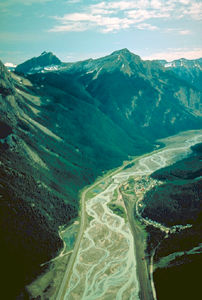Indigenous Peoples
Kicking Horse Pass was used primarily by the Ktunaxa (Kootenay) as a seasonal route to the plains on the eastern side of the Rocky Mountains. While other routes existed to the south of the park, these southern passages put the Ktunaxa in contact with the Siksikaitsitapi (Blackfoot Confederacy), with whom they were not friendly. Instead, the Ktunaxa likely used Kicking Horse Pass to access the plains, where they hunted bison on the territory of their allies, the Cree and the Stoney-Nakoda, and traded ochre with them.
History

In 1858, James Hector, a Scottish geologist travelling with the Palliser Expedition, became the first European to encounter Kicking Horse Pass. It’s said Hector’s horse kicked him in the chest at this juncture, hence the name of the pass. Later, the Canadian Pacific Railway used the corridor to connect British Columbia to the rest of the country. Despite Kicking Horse Pass’s severe inclines construction was completed in 1884.

 Share on Facebook
Share on Facebook Share on X
Share on X Share by Email
Share by Email Share on Google Classroom
Share on Google Classroom